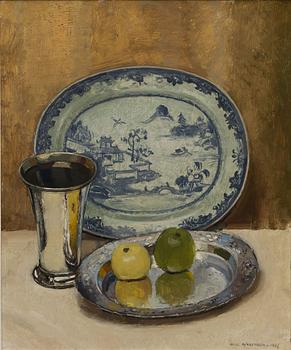Gazing Outward – Plein Air Painting in Sweden F653
The development of realistic plein air painting in Sweden during the late 19th century represents one of the most significant artistic turning points in Swedish art history. It was regarded a liberation from the increasingly stagnant academic tradition upheld by the Royal Academy of Fine Arts and paved the way for modern art. This auction presents works of plein air painting primarily from the late 19th and 20th centuries, by artists such as Per Ekström, Oskar Bergman, Olle Hjortzberg, and Robert Thegerström. We also include a contemporary work by Lars Jonsson, whose practice has been deeply influenced by the realist plein air tradition.
The major breakthrough for Swedish plein air painting occurred in the 1880s. A growing number of young Swedish artists began settling in France, rather than Germany as had previously been the custom. In France, the realist plein air movement had already had its breakthrough in the 1840s through the work of artists such as Camille Corot and Théodore Rousseau. This shift was facilitated by the English firm Winsor & Newton’s invention of ready-made oil paint in tubes in the 1840s, which enabled artists to increasingly turn their gaze outward, beyond the walls of the studios and academies, and depict the surrounding world directly. With easels and paint in hand, they positioned themselves along country roads, in town squares, and on seashores, intent on capturing the world around them with immediacy and authenticity.
Swedish artists increasingly sought training at Parisian academies such as the Académie Julian and the Académie Colarossi, and also ventured into the French countryside to study nature en plein air. Artists like Carl Larsson and Karl Nordström discovered the village of Grez-sur-Loing just outside Paris, where they chose to settle. Over time, more Scandinavian artists followed, and a vibrant artists’ colony emerged. Carl Larsson’s own words vividly reflect the spirit of the time: “Now the scales had fallen from my eyes, and the enchantment was broken. For the first time, I looked at nature. [...] No, now I have embraced nature, however simple she may be. The fertile, lustful earth shall now become the subject of my painting.”
In 1884, a group of Swedish artists residing in France gathered at Ernst Josephson’s studio residence in Montmartre, Paris. United by a shared dissatisfaction with the Royal Swedish Academy of Fine Arts, which they considered to hold an outdated view of art, they looked to French Realism as a new artistic direction. At Josephson’s studio, they discussed the need for reforming the Academy and modernizing Swedish art. The group resolved to organize a collective exhibition on Swedish soil. The result was the exhibition "From the Shores of the Seine", featuring works by eighteen Swedish artists. It opened in the spring of 1885 at Blanch’s Art Salon in Kungsträdgården, Stockholm. In many ways, the exhibition marked the beginning of a new era in Swedish art history.






































